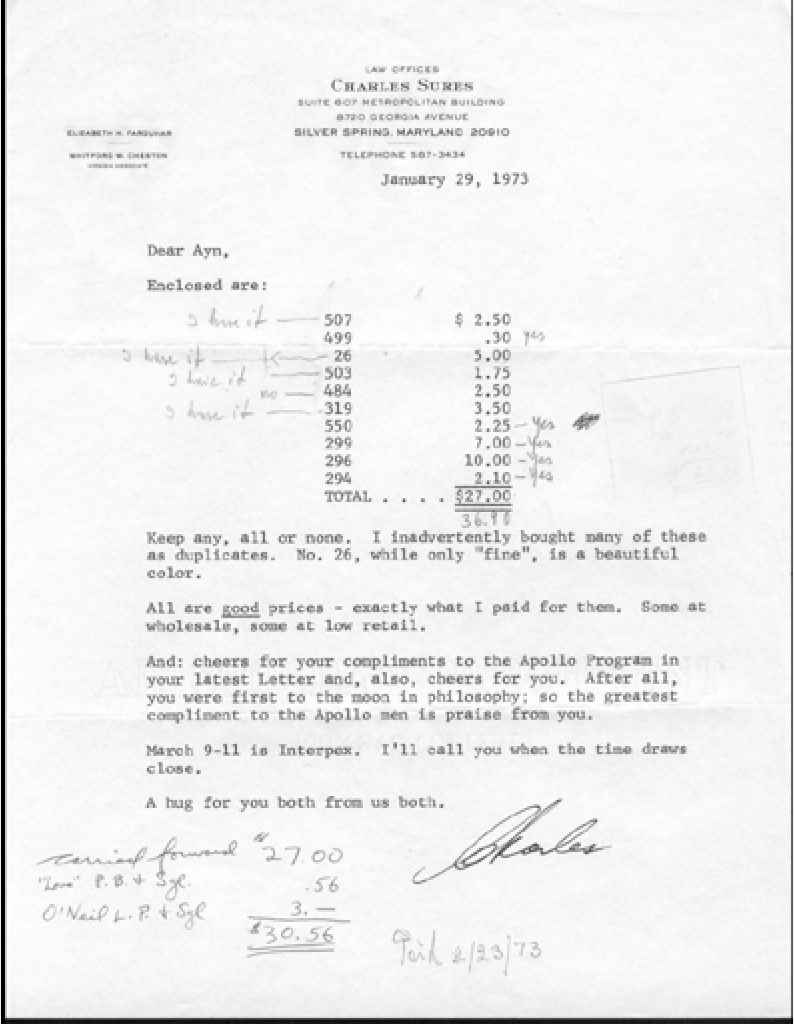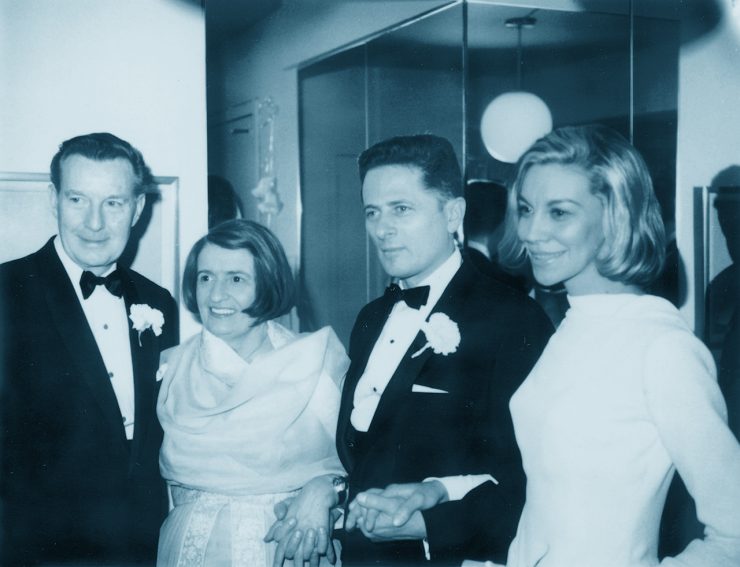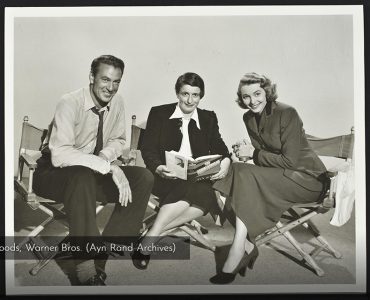In 2001, the Ayn Rand Institute Press published Facets of Ayn Rand: Memoirs by Mary Ann Sures and Charles Sures, based on forty-eight hours of interviews conducted by oral historian Scott McConnell from September 1998 to January 1999. Twenty years later, these entertaining and informative personal reminiscences still merit careful study and reflection. New Ideal is proud to present the entire book online in eight installments.
Start with Part 1 here
FINISHING ATLAS SHRUGGED
ARI: Were you there when Miss Rand finished writing Atlas Shrugged?
MARY ANN: Yes, that is one of my most vivid memories.
ARI: What happened?
MARY ANN: Atlas Shrugged was finished on the afternoon of Wednesday, March 20, 1957. That, incidentally, is the date she wrote on the last page of the manuscript. The only people there, besides Ayn, were Frank, Joan, Leonard, and me.
At the time, Ayn was working against a deadline, a date when she was scheduled to turn in the final typed manuscript of the novel to Random House. My job was to get the typing and proofreading finished by that deadline. I had agreed with Ayn not to let the work pile up; I was to keep up with her. On March 20, there were typewritten pages to be proofread. I had typed them earlier in the week, and I asked Joan to proofread with me. Ayn knew we were coming over.
We arrived at the apartment after lunch, about 1:00 p.m. We knew Ayn was writing the last chapter but we didn’t know how close to the end she was. Frank answered the door, and said something like “I think this is going to be it, kids.” Then, he went back to his easel in the bedroom.
As I said earlier, whenever I went over to do some work and she was writing, I would tap on the study door, enter, take my work, and leave. But, after hearing Frank, I decided that we should not disturb her. We sat in the living room, whispering. More than an hour passed. Finally, I thought that one of us should quietly enter the study and quickly take the manuscript pages we needed — I knew exactly where they were on the bottom shelf of the bookcase. But, which one of us?
ARI: Which one was it?
MARY ANN: Joan. How we decided that Joan should be the one is amusing. We concluded that since she was petite, she would be less noticeable! I told her to tap lightly and enter. She walked back to the study, and here is what I heard: a few taps on the study door, followed by Ayn’s voice speaking in a stern manner: “If you come in here, I’ll kill you.” That’s an exact quote. Joan returned, and we retreated to the farthest corner of the living room and sat whispering and wondering. I decided to call Leonard and tell him what was happening. I had to go down to the lobby to use the pay phone, because the only telephone in the apartment was in Ayn’s study. Leonard lived a few blocks away, and he came right over. He joined us in the corner of the living room, and we three whispered and waited. I’m not sure how much time passed; it seemed like hours, but it wasn’t. And then we heard the loveliest sound in the world — Ayn’s chair scraping against the wooden floor. We heard her footsteps walking out of the study, we heard Frank say, “Congratulations, darling.” Then we heard her walking into the living room. She entered, dressed in a skirt and short‐sleeved blouse, her hair was somewhat disheveled, her face was a little shiny. She was walking toward us, holding up a manuscript page with her thumb and index finger. We approached her and read the words “The End” at the bottom of the page. She looked young, she was smiling broadly, her eyes were bright. Frank followed her in, and he was beaming.
ARI: Was she angry about the interruption?
MARY ANN: She didn’t even mention it. After hugs and congratulations, we apologized for disturbing her. She dismissed it with a wave of her hand. She said it was all right, that we had no way of knowing what page she was on. She was so happy in those moments, I don’t think anything could have undercut her joy at having finished Atlas. She wanted to have the Collective1 over that night to celebrate. Then we left. It was still daylight.
ARI: How did you celebrate?
MARY ANN: We had champagne. The “If you come in here, I’ll kill you” story was told, to everyone’s amusement. Ayn said that she didn’t know who was tapping on the study door. We had coffee and pastries. I remember picking up some at the bakery on Third Avenue that the O’Connors used, Versailles Patisserie.
ARI: Were there any pictures taken, just after she finished writing the last page?
MARY ANN: Right after she finished? No. No one had a camera. If we’d had a camera, we would have snapped her as she walked into the living room holding up the last page!
ARI: Do you remember typing the last page?
MARY ANN: I typed only part of it. As I was typing the last chapter, Ayn said I could type everything but the last lines. She wanted to type those herself. When that time came, she sat down at the typewriter and said that even though she was a fast typist, she made a lot of mistakes. She added that she better not make any this time. So she typed, very slowly, from “He raised his hand….” to “The End.” After she finished, she said, “Now it really does say ‘The End’.”
CHAPTER TWO
AYN RAND AND CHARLES SURES
MEETING AYN RAND
ARI: Charles, when did you meet Ayn Rand?
CHARLES: February 1960, in New York City. Branden was giving lectures on Objectivism, and I knew that she came for the question period to answer questions. At the end of the evening, I went up to the podium, and I introduced myself. But we didn’t have a conversation. Some of her friends were there. They were going out for coffee, and I was invited along. The next thing I knew, I was walking down the street and talking with Ayn Rand.
ARI: How did it happen that you were walking with her?
CHARLES: As we were leaving, people broke up into couples, and I saw that she was walking with Frank. There was this whole side of Ayn Rand unoccupied, and so I hurried over to fill the gap.
ARI: What do you remember of that meeting?
CHARLES: I remember that what happened surprised me. I was glowing inwardly at my good fortune. At most, I had expected to introduce myself that evening, maybe have a brief conversation, and then leave. But, there I was, walking with her! I was thinking of what to say. But she took over, and began the conversation. I thought she would want to talk about the lecture or some aspect of the philosophy. But no, she was interested in me — who I was, what I did for a living. When I told her that I was an attorney and had come from Washington, D.C., to hear her, she smiled and said it was a compliment to her that I had come “so far,” and it indicated a serious interest in ideas. She wanted to know what aspect of the law I specialized in and what I enjoyed about my work. It was the focus on me that I hadn’t expected. You would have thought that I was the celebrity.
ARI: What were your impressions of her?
CHARLES: In manner, she was a very gracious lady. I would say she was friendly, but not familiar.
ARI: Would you say she was formal?
CHARLES: No, formal is too strong a word. I’d characterize it as more of a cordial reserve. There was a respectful distance, but there was also civility and an attitude of good will. I believed that she was genuinely interested in me. Frank was that way, too.
I don’t remember what else we talked about. At one point, she was speaking and we were about to cross a street. She started to step off the curb — without looking. I took her arm to stop her and she looked up at me; she seemed a little surprised. But I had the impression she approved of the protective gesture. I also remember that she went right on speaking to make her point, as if there hadn’t been an interruption. That, I learned, was typical of her: nothing distracted her; she never lost her train of thought. She never paused to say things like “What were we talking about?” or “Where was I?” She always knew.
ARI: Did you see her after that?
CHARLES: I saw her whenever I could. I traveled to where she was speaking — Philadelphia, Boston, New York. In fact, she was there when I met Mary Ann. In 1962 Ayn gave a lecture at Hunter College where Mary Ann was teaching. I knew who Mary Ann was, but she didn’t know me. After the lecture, I followed Ayn and her friends into an elevator, and Mary Ann and I were introduced. But I didn’t get to know Ayn on a personal basis until I started to date Mary Ann the following year and went to social gatherings attended by Ayn and Frank. That was really the beginning of my relationship with Ayn.
STAMP COLLECTING
ARI: Charles, at the U.S. Post Office ceremony introducing the Ayn Rand stamp, you gave a short speech about stamp collecting with Miss Rand. Did she get you interested in stamps and collecting?
CHARLES: Actually, she revived my interest in stamps with the article she wrote for the Minkus Stamp Journal in 1971 — “Why I Like Stamp Collecting.”2 It got me into collecting stamps again, instead of just accumulating them.
ARI: How do you mean?
CHARLES: Until I read that article, I had the mistaken notion that stamp collecting was a nonintellectual endeavor for children. I had a stamp collection when I was a child, but over the years I drifted away from organized collecting habits. I stopped putting stamps into albums. I had a box in which I put the stamps I liked personally, that’s all. Then I read the article and my return to collecting began. She explained the many ways in which that hobby was a legitimate intellectual and enjoyable pursuit for an adult. It liberated me, and opened up a world of pleasure.
ARI: How did you get involved with stamp collecting with Miss Rand?
CHARLES: It was gradual. My intent was to collect the dozen or so of her favorite stamps that were illustrated in the article, and to do no more than that. But once I had collected her page of stamps, I was completely in thrall. When I told her what I had done, she was delighted and encouraged me to continue. Soon after that, we became fellow collectors, in earnest.
ARI: What did this involve?
CHARLES: One project involved a collection I had purchased at an estate sale — twenty stamp albums, each album of a different country, about twenty thousand stamps in all. I got it at a very good price. Actually, I didn’t get it for myself. I bought it so she and I could have some fun with it. She collected worldwide; I only collected American, so it suited her interests.

ARI: Did she buy them from you?
CHARLES: Individual stamps, yes, but not whole albums. Our agreement was that I would deliver a few albums to her, she would select the stamps she needed, and I would then take back these albums and replace them with a few more. This went on for about a year and a half. She was scrupulous about keeping records and paying me for the stamps she bought. She carefully marked which stamps she had taken, or made a list. I kept a running account of what she owed me and would bill her from time to time.
ARI: How did you arrive at the price?
CHARLES: We agreed on two cents a stamp, as a general rule, based on what I had paid for the collection. But if we thought that the value of a particular stamp was significantly higher, she used the catalog value as a guide to decide upon a price higher than two cents.
It was a real bargain, the way I figured it. I broke even on the investment except for the million bucks worth of pleasure I got from our discussions and negotiations, and from knowing that I helped her acquire about fifteen hundred stamps for her collection.
ARI: How large was her collection?
CHARLES: By 1974 she had about forty‐five thousand stamps, all of which she knew from memory. She was phenomenal in that regard. She knew exactly what she owned, and she never mistakenly bought a duplicate. She kept an exact count of her collection, and whenever I asked she had a figure at hand. The last count was something more than fifty‐two thousand stamps. It was a worldwide collection, but she would not, and did not, collect stamps from communist countries.
ARI: Was her collection distinguished in any particular way?
CHARLES: Yes and no. It was not unique, but it was vast. In terms of size, it was out of the ordinary. And it was so well kept it was a pleasure to casually leaf through it. But it was not particularly valuable, which resulted from her approach to stamp collecting.
ARI: What was that?
CHARLES: She did not collect for investment, as some philatelists do. They insist on the best quality and they search for rare stamps, all with the expectation that the value of the collection will increase. Ayn collected for keeps and never intended to sell. She was not a stickler for perfect quality in stamps, but they had to be more than merely presentable. They had to be good‐looking and above‐average quality — not faded or torn. She acquired both unused and used stamps, but she preferred the unused ones.
When she first started filling up albums, she attached the stamps to an album page with special hinges that required physically gluing the stamps to the page. Later, she used mounts which held the stamps securely in place without gluing. This practice preserved the mint condition of unused stamps. Like all dedicated stamp collectors, she was concerned with preserving and presenting her collection in the best, most attractive way possible. She was very proud of it. If she had added many new stamps to an album, or if she had completed a page, she brought it out to show me. She never tired of going through an album and commenting on particular stamps. Her enthusiasm never waned.
ARI: Besides the twenty albums, did you help her acquire other stamps?
CHARLES: Sure. I attended more stamp shows than she did, and before I went to one, I would check in with her to see if there was anything she wanted. She would give me a list of stamps she needed and the price range for each one. I made a number of purchases for her over the years and kept up the accounting. There were times when I purchased a stamp she didn’t have and which a good collection should have, but which was expensive. I would tell her that if she didn’t want it, I would keep it in my collection. I meant it, even though the stamp was a duplicate of one I owned. But she always bought it.
ARI: Did you give her any stamps as gifts?
CHARLES: Yes, but at her insistence we agreed that I could not spend more than two dollars on a stamp gift for her. As a general rule, Ayn did not like to receive gifts from admirers, and it was her policy to return a gift if she had not met the person or knew that person only casually. She said that accepting a gift created an implied obligation upon her to reciprocate, and she thought it an “enormous” — one of her favorite adjectives — presumption, especially if she had not met the person sending the gift.
ARI: So accepting two‐dollar stamp gifts from you was an exception?
CHARLES: A very happy exception. And it was one way of reciprocating for the times I stayed overnight at the O’Connors’ when in town for a stamp show or other business.
ARI: We’ll have to talk about those overnighters. But, first, tell me about Miss Rand and the stamp shows.
CHARLES: There were two large shows in New York City, one in the spring and one in the fall, and we tried to make it to at least one of them, and some years we went to both. Over the years, Ayn and Frank did not initiate many phone calls. Mary Ann and I did most of the calling. But she never failed to call about the date of a stamp show and make arrangements to go if she could.
They were all‐day affairs and could be tiring. There were hundreds of booths and tables for the dealers, and thousands of people attended. But she was a trooper; she had the stamina. She said she found that just being there was energizing.
She approached a stamp show in a very business‐like way. She always came prepared with a list of what she needed. Also, she had a stamp budget. On the way to a show, she would declare a budget limit — usually around three hundred dollars. But if she found a stamp that exceeded her budget, she would pause, look at me, and ask, “Should I?” I always said, “Yes,” whereupon she treated herself to it with a kind of resigned sigh of pleasure — as if she were succumbing to the irresistible. Like all collectors, she went over budget. But I can’t recall any stamp purchase over four hundred dollars.
When we entered a show, we were given name tags to wear, and she always wrote “Ayn Rand” on hers, not “Ayn O’Connor.” She was proud of being a stamp collector and wanted to go as the author of her article on stamp collecting.
ARI: Was her name recognized?
CHARLES: In all the stamp shows we went to, it was recognized only once. But she didn’t mind. She said that it meant that people there were concerned with stamps, not with celebrities, and that’s the way it should be. She liked the atmosphere of camaraderie and good will at these shows.
ARI: How do you mean?
CHARLES: People there were motivated by a value they held in common — the love of stamps. She said you could see it in so many forms: dealers had their wares neatly arranged, a few dealers remembered her from previous years and were happy to see her again. She saw people studying stamps intently. They were people with a purpose, she said. There was only one occasion when the good will was lacking.
ARI: What was that?
CHARLES: At one show, she was examining an attractive stamp at a dealer’s booth. When he saw that she was interested in it, he brought out several examples to show her. When she indicated that she was not in the market for the stamp at that time, he got impatient and brusque in manner. Ayn was silent for a few seconds and then she looked up and quietly asked, “Have I offended you?” The dealer was embarrassed and apologized and became a gentleman again. His behavior was an exception to the pleasant atmosphere, but it was jarring. This incident led to a discussion with Ayn that I found touching.
ARI: Tell me about it.
CHARLES: A few hours later, Ayn and I were having hamburgers and coffee. I noticed a slight frown in her expression, and I asked if anything was troubling her. She acknowledged that she felt a little depressed, and I asked why. She said she was not sure at the moment. I asked if it was caused by the rudeness of the dealer, and she said she didn’t think so. Then she expressed appreciation for my trying to help. She said she appreciated it because I wasn’t treating her as if she were from the stratosphere, that I didn’t back away from the situation on account of her being who she was. Then she asked me if it troubled me to see her get down over something. I assured her that it didn’t. And she added that it was a change from her usual role, where she was the one bolstering someone else’s spirits.
ARI: Did she ever say what was troubling her?
CHARLES: No, and I never inquired. She never raised the subject again, and that meant that she didn’t want to talk about it. I felt free to discuss anything with her except matters which I considered were entirely private to her or were entirely private to me. Ayn respected privacy. She didn’t probe into areas of your private life, and she expected you to keep out of hers.
ARI: Did that incident undercut her pleasure in stamps that day?
CHARLES: No. At every stamp show, we both made purchases — of stamps, or souvenir sheets, or supplies. And the first thing she wanted to do when we got home that day was to unpack her purchases and show them to Frank. She was happy.
ARI: Did Mr. O’Connor ever go to the stamp shows? Or Mary Ann?
CHARLES: No. They weren’t interested the way Ayn and I were. I shared Ayn’s attitude, that stamp shows were for dedicated enthusiasts, not onlookers. So Frank and Mary Ann weren’t invited.
ARI: What did they do while you were gone?
CHARLES: If Mary Ann was in town with me, she and Frank would spend the day doing what they enjoyed. They liked to stroll around New York and window shop, or go to a department store and browse through the home decorating department. But after a show, the four of us would have dinner together. Ayn always wanted a report from Frank about what he did that day.
On many occasions, when Ayn and I were leaving for the day, Frank would say, “They’re off stampeding again!”
ARI: You once wrote to Miss Rand in response to her inquiry about the possibility that some stamps she bought might be counterfeit. What was the outcome of this?
CHARLES: Ayn had a set of U.S. stamps known as the Kansas‐Nebraska overprints. Counterfeiters found it easy to print the name of the state on the plain original issues to make them appear as the specially authorized over‐print stamps. Experts can tell the genuine from the false, and Ayn wanted this assurance; they ruled her stamps genuine.
ARI: Did Miss Rand ever give you a gift of stamps?
CHARLES: We didn’t exchange gifts, except for small hostess gifts that Mary Ann and I would take over. But she did select two stamps that our friends, including Ayn and Frank, gave me for my fiftieth birthday. Mary Ann gave me a party in New York at Joan and Allan’s apartment. All our friends chipped in, and Mary Ann asked Ayn to select the stamps. Ayn knew what my collection lacked, and purchased two rare stamps in perfect condition from Jacques Minkus, the famous stamp dealer.
She was delightful that evening. During the party, she asked me to sit on the couch near her. She then announced to all present that she had gone over my latest accounting for stamps and found that I had made a ten‐dollar error in her favor. She produced a ten‐dollar bill and, waving it with a flourish, made this light‐hearted comment; “It’s a good thing I’m honest.” And I love the greeting she wrote on the group birthday card.
ARI: Which is?
CHARLES: “Happy Stampeding!”
AYN RAND AS HOSTESS
ARI: Let’s talk about those overnight stays. What was a visit to Miss Rand like?
CHARLES: She jokingly called me her “corner tenant.” She explained that in communist Russia, living quarters were at a premium, so much so that a person who had an apartment could rent the four corners of a room to tenants. So I became her “corner tenant” — without paying rent, of course.
Ayn took seriously being a hostess. She made sure her housekeeper had everything ready for my stay. She pointed out the fresh towels in the guest bathroom; there was always a fresh bar of soap; she reminded me of the juice and sandwiches in the refrigerator.
There was an amusing ritual. She explained that the cats, being mischievous, were not permitted in the living room overnight. Their seclusion was guaranteed by implementing what she jokingly designated “the decompression chamber.”
ARI: What was that?
CHARLES: A long hallway connecting the living room with the master bedroom. There were doors at each end. The cats stayed in the bedroom and were prevented from escaping into the living room by the policy of never having both doors to the “decompression chamber” open at the same time. This saved her and Frank from chasing cats. The guest bathroom and her study were off this chamber, and if I entered it I had to make sure there weren’t any cats in it waiting to escape. “All clear,” Ayn, Frank, and I would call out from time to time.
ARI: When you were there, did she cook?
CHARLES: She might make coffee or tea, but not meals. Either we ate out or dinner was prepared and served by Eloise.3 I know that Ayn supplied many of the recipes.
ARI: What was a typical dinner like?
CHARLES: In service, it was formal in the sense that the table was completely set and Ayn had a crystal bell at her place to summon Eloise, which she did between courses. Ayn sat at the head of the table, with Frank opposite her. Even though we might all be in casual clothes, dinner was genteel. There was an elegance to the occasion.
ARI: What was served?
CHARLES: Complete dinners, usually with salad as an appetizer and a main course, with vegetables. One of their favorite dishes was beef Stroganoff, made from a recipe Ayn had brought from Russia, and that was served a few times. One year, Mary Ann and I were there a week before Thanksgiving. Ayn had Eloise prepare a complete Thanksgiving dinner with turkey and all the trimmings, and we all celebrated in advance of the holiday. There was always coffee or tea and dessert, which was usually several flavors of ice cream and often a Russian nut cake made by Eloise. Ayn always made sure that Frank, who was on the thin side, had balanced, nutritious meals.
During the evening, Frank or Ayn made coffee and served it with miniature Danish pastries or cookies. And there were always soft drinks available, your choice of Coca‐Cola or Pepsi. Their guests were well taken care of.
There were times when Mary Ann and I spent the afternoon with Ayn and Frank on an outing but were not going to stay for dinner. On the way back to their apartment, Ayn and Frank always stopped at the delicatessen in the building and purchased some cold cuts for a snack for us before we left.
ARI: What were evenings like after dinner?
CHARLES: I enjoyed talks that lasted into the early morning hours. Ayn was not indefatigable, but I never met anyone who outlasted her. She might get tired, and she might unabashedly yawn, but she was never the first to call an end to the evening. Frank usually turned in before we did. If I yawned, she would say, “OK, that’s it,” and we would call it a night. She would tell me to help myself to anything I wanted in the refrigerator. And she would then proceed to make up the couch with sheets, pillow, and blanket. I told her that I would make up the couch, but she always insisted on doing it as a service, she said, for her “corner tenant.” I never got used to her doing chores like that. I never forgot who she was and what she had accomplished.
As a guest, I have a special recollection of a January 1. We had been to a New Year’s Eve party, and Mary Ann and I drove them home. We had planned to drop them off and go directly home to Maryland, where I had to prepare for a trial. They expressed concern about the five‐hour drive, and they urged us to come up with them for a rest and a bite to eat before our journey, which we did. Now, the living room windows of their apartment looked down on 34th Street, where I had parked the car across from their building. We said our goodbyes, which included their admonitions to drive carefully, to stop and rest at diners, and so on. We walked to our car and looked up and there they were, Ayn and Frank, standing at the window, making sure we got into our car safely, and waving to us. It was an endearing sight.
Copyright © 2001 Mary Ann Sures; Introduction copyright © 2001 Leonard Peikoff; all rights reserved.
Readers seeking a superior print result may wish to download the free Just Read app.







